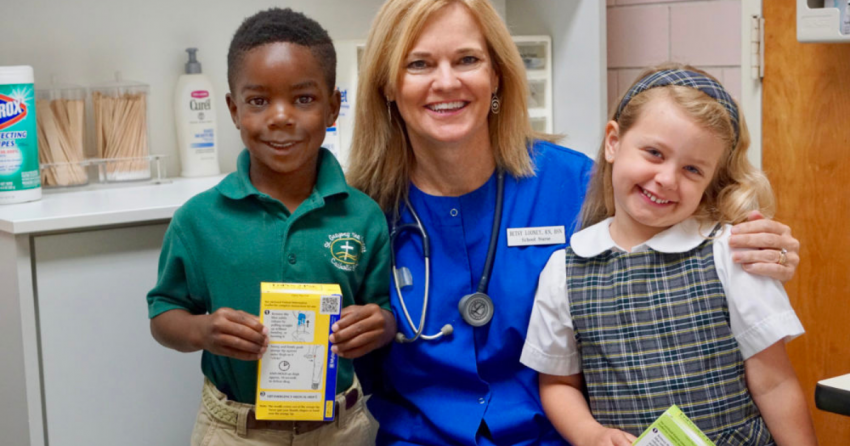As children across the nation head back to school this fall, nurses within the school systems are playing a more important role than ever. School nurses help assess and maintain the health of school employees and students. During this pandemic, they are responsible for deciding if a child or staff member should remain at school and when they should be tested for coronavirus, a crucial role in public health to stop the spread throughout the school and wider community.
School nurses are getting their voices heard in their districts, and are expressing important opinions and data related to the reopening of their school systems. School nurses may also be responsible for tracing coronavirus symptoms and contact tracing, as well as making sure vaccine records are up to date, as some schools are making the flu vaccine mandatory. During COVID, school nurses will also communicate with local health departments and convey real-time data regarding prevalence and symptomatic patients.


Schools going back during COVID-19
States across the nation are investigating the safety of returning to school and trying to prepare as much as possible. Rhode Island, the District of Columbia, and Puerto Rico are still under state-ordered closures. According to the Education Week publication, Iowa, Arkansas, Texas, and Florida are mandating some sort of in-person instruction, though the amount of days required per week varies. Other states are trying a hybrid model using remote learning, or some in-person instruction days depending on the school district.
Despite the fact that school districts have taken preparatory steps and increased environmental cleaning, some have already had to shut down due to an increasing prevalence in COVID among the students and staff. Almost every day there is a news story about another school having to close due to new COVID cases. Additionally, college campuses are struggling with how to contain the virus amongst their student populations.
CDC Guidelines provide considerations for safely reopening schools and in-person classes. School nurses will stay up to date on these guidelines to help schools manage and assess the effectiveness of the additional measures in real-time.


Schools nurses are at increased risk
The value of a good school nurse cannot be underestimated. These nurses are continuously interacting with the public, and their acceptance of that risk speaks to the honor of the nursing profession. When a child becomes ill at school, they go to the nurses’ office. School nurses are being repeatedly exposed to children with symptoms. It’s important for school nurses to ensure they have enough proper PPE, and to be up to date on the school’s protocols if a child or staff member possibly has coronavirus.
There is a shortage of school nurses
According to the NASN data (National Association of School Nurses), schools did not have enough nurses for full-time coverage, even well before the pandemic began. There is an increased demand for school nurses and traveling school nurses to fill already open positions, as well as provide backup coverage if a full-time school nurse becomes ill. NASN is calling for an additional 10,000 school nurses to help carry the burden as schools start to reopen.
For the nurses already in the school nurse role, the National Associate of School Nurses has some great resources and has started a survey to gather more data regarding the impact of COVID-19 on school nurses.
Consider a job in School Nursing
School nursing is a rewarding profession, and these nurses play a pivotal role in ensuring the children and staff are safe, healthy, and get the most out of their education.
Registered nurses who hold an Associate’s degree, and sometimes even Licensed Professional Nurses, are often eligible to apply for this type of position, although the National Association of School Nurses recommends hiring RNs with a 4-year BSN degree who have passed the NCLEX-RN exam. Most schools prefer to hire nurses who have a few years of experience in a clinical setting, as school nurses must make critical decisions without a doctor on-site to assist them. Pediatric experience can be helpful in the school setting.
According to data on NurseFly, School RN travel assignments pay on average $1,392 per week.
Read more about What do School Nurses Do.
Now is the time to find a traveling school nurse job with NurseFly!
Advice for your sending your child back to school:
- Your children may have different symptoms than an adult if they contract COVID. Often the symptoms are less severe or non-existent. Keep in mind that the child can still transmit the disease, even without symptoms.
- Teach your child proper handwashing, and send them to school with hand sanitizer if they are old enough to use it properly
- Encourage your child to wear their mask at all times during in-person interactions.
Sending your child back to school, or in-person classes is a personal decision. Assess your options and what is best for your child and your household. Refer to CDC guidelines for the most up to date recommendations.
Read our Q&A articles with Featured School Nurses:


Read our Q&A with School Nurse: Kayla Rachels Ellis


Read our Q&A with School Nurse: Nurse Katie
Read More about School Nursing:
Looking for Healthcare Jobs?
Explore jobs and compare agencies with NurseFly or create a profile and let the offers come to you.





Are the schools hiring LPNs also? I would love to help out .
in my opinion I believe you.could hire a cna to aid the nurse at half the pay train them with an Rn and ofcourse be under the roll of rn and her instructions and her or his orders and reverse gender as rn so the aid could also assisted with RN care with students the money that would save would be a huge difference